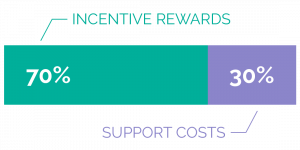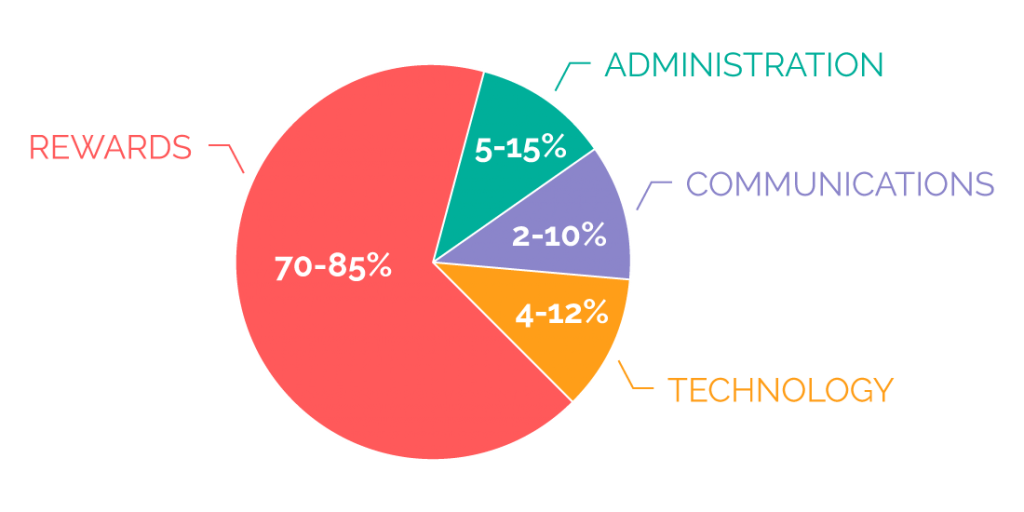So, you are in the market to start a channel partner incentive program to boost your ROI, but you have no clue where to begin with your budget. You want to impress your supervisor; therefore, you do your own research, but you find your brain is a bit overloaded with numbers, data, and cat videos with not much to say for yourself.
What is the Cost of a Channel Partner Incentive Program
Here is a simple rule-of-thumb for the annual budget breakdown of a channel incentive program:
- 70% of the total budget should fund the incentive rewards
- 30% of the total budget should fund the support costs
You can further break down support costs into 10% for communications, 10% for technology, and 10% for administration.
For larger programs, the rewards investment could be higher and the support investment lower because of the economies of scale. A $1,000,000 channel incentive might be 85% awards and 15% support. For programs that are small, short, or complex, the support percentage could be higher.
We have broken down these costs into digestible pieces:
- Initial Set-Up Costs
- The Fixed & Variable Costs
- Budget Averages
- Budget Categories
- Cost of Channel Incentive Software & Options
- Average Award Amounts to Channel Sales Reps
- Final Thoughts & Recommendations
1. Initial Set-Up Costs for a Channel Partner Incentive Program
The costs to launch a new channel incentive program start around $10,000 for a channel incentive website plus $5,000 for promotional communications (graphic design, email templates, and announcement flyer) plus another $5,000 for incentive design consulting and the professional services to start the whole project. That means $20,000 total is a reasonable estimate to set up a new partner incentive program professionally.
For small partner incentives with a total budget of less than $50,000, the initial set-up costs can be tough to absorb unless the sponsoring executive is forwarding thinking and wishes to re-use the website for future quarterly or annual incentives.
2. Fixed & Variable Costs for Channel Partner Incentive Programs
Like most business projects, incentive programs are a mix of fixed and variable costs.

Rewards are a variable cost that is driven by eligible product sales.
Technology, or the software platform, is a mostly fixed cost for the original set-up. As extra functionality is added this will increase for larger or more complex programs. Variable, ongoing, monthly support costs exist for the software licensing, website hosting, and maintenance.
Administration is primarily variable based upon the participant enrollment, claim achievements, award fulfillment, and customer service requirements.
You may also want to keep in mind “Program Management.” This is a more accurate term for these professional services that include value-added expertise in channel strategy, participant engagement, incentive design, and motivational award consulting.
3. Budget Averages for Channel Partner Incentive Programs
Here are the historical averages for hundreds of incentive programs – ranging from $25,000 quarterly spiffs to $1,000,000 annual partner reward programs.
At Brightspot, we refer to this budget allocation as the “budget pie.” Like grandma’s apple pie, all the ingredients must be properly portioned for tastiness. For channel sales, the incentive budget pie must be balanced properly for incentive success, motivated employees, and positive ROI results.
4. Budget Categories for New Channel Reward Programs
The following is a deeper look at each budget category – along with Brightspot commentary based on our experience managing hundreds of incentive rewards programs across many industries, timeframes, geographies, and award types.
REWARDS
The rewards and prizes comprise the most significant portion of the incentive program budget. Most of the award budget needs to get into the hands of the participants. Suppose only 50% of the budget is going toward rewards (rather than the 70% benchmark). In that case, it usually means the sponsor is making the incentive too complex, thereby driving up the support costs.
The most common award types are merchandise, travel, gift cards, or Visa prepaid cards. Merchandise is usually redeemed via points in a curated catalog and is most prevalent in international reward programs due to tax laws around the globe and cultural nuances. Travel is always extremely popular, whether it’s a “club trip” for top achievers or individual prize packages. Using precise incentive industry vernacular, gift cards are redeemable at a single merchant, such as Best Buy, Target, Nordstrom, Sephora, Subway, Starbucks, and many other places. A gift card catalog offers freedom of choice that channel sales reps appreciate. Visa prepaid cards are popular with value-added reseller (VAR) incentives. Many times you will find these cards are used in the software and technology industries even though it comes with the downside of incentivizing cash-like rewards for all future rewards. Recently, a virtual Mastercard has become an effective technique to send cash rewards around the world electronically.
Understanding the incentive audience helps a good incentive company recommend exciting awards that will motivate the partner participants. Be sure to consider both the audience demographics and psychographics. And, avoid the common mistake of choosing rewards that are meaningful to you rather than those that appeal to the target audience.
Once upon a time, a well-to-do female client wanted high-end rewards from Neiman Marcus, Tiffany’s, Nordstrom, and Sur La Table to symbolize the new channel incentive was equally high-end and important. However, the channel reps were younger males selling technology solutions, so Brightspot recommended more male-oriented rewards. After initial resistance from the female sponsor, feedback from the channel reps shifted the rewards to those appealing to a male audience.
TIP: Look out for “incentive” companies that recommend the same award type for every business need. Always a trip, always a merchandise item, or always a Visa card. Those are incentive fulfillment companies and not full-service incentive providers that will recommend rewards to match each client’s needs.
COMMUNICATIONS
Channels are inherently challenging to reach because the reps might sell 10-20 different brands, so breaking through the clutter is tough without strong, repetitive communications. Brightspot coined the term “quota share” to reflect the percent of a rep’s total quota attributable to a specific brand. Small quota share likely indicates small mindshare and small heartshare – that needs more communications (and richer incentives) to drive home a new marketing message and stimulate more sales.
Brightspot recommends developing a communications plan that includes a teaser announcement to create suspense, kickoff announcement to communicate the rules and rewards fully, emails for monthly communications, and electronic statements with reward earning activity. If many channel reps are concentrated in the same locations, posters, print flyers, and postcards are cost-effective opportunities to drive home your messaging.
Make the appropriate investment to capitalize on a great reward by making sure participants know what to expect throughout the incentive program, to create excitement for the sales contest, to understand which products are eligible, and to promote the channel rewards using multiple mediums.
The #1 most common mistake with incentive programs is underfunding the promotional communications and blasting out a single email. If this is done, you will find the incentive becomes the best-kept secret.
TECHNOLOGY
Nowadays, customizable incentive websites and tracking databases add efficiency, scalability, and reporting required by participants, management, and the IRS.
- When does it make sense to use channel incentive software?
- When does it make sense to use an Excel spreadsheet, Outlook emails, and an administrative assistant?
If a channel partner incentive program has over 100 participants or $50,000 in total rewards, a channel software platform (like Brightspot’s Ignite software) will make the channel exec’s job easier and look more professional too.
Technology is so important and varied that it merits a deeper dive – see Cost of Channel Incentive Software section below.
ADMINISTRATION
The administration, or incentive program management, includes the professional services of customer service (to both participants and plan sponsor), enrollment, achievement processing, point scoring, reward fulfillment, performance measurement, tax reporting, and feedback.
The incentive design services are often overlooked. This includes the incentive design of program rules, promotional offers, eligibility, reward types, and reward values. The incentive design expertise might be the most valuable consulting, but it’s often overlooked by companies until they experience the benefits firsthand.
Our incentive pros at Brightspot have designed hundreds of top channel incentive programs for many Fortune 1000 companies. Multiple industry awards, such as Motivation Masters Awards and ‘Best Incentive Program’, prove their expertise.
Hiring a good incentive agency will maximize ROI with their efficiency of implementation, incentive advice, ongoing management, and accountability that they provide.
5. Cost of Channel Incentive Software & Your Options
A good channel incentive software platform, like Brightspot’s Ignite software, pays for itself by communicating, tracking, fulfilling, and reporting the whole incentive ecosystem in a single portal. The cost for channel incentive software website starts around $10,000 for:
- Mobile responsive website
- Graphic design of themed web and email headers
- Attractive incentive templates, menu bars, and page layouts
- Content pages for program rules, promotional offers, terms & conditions, FAQs, contact us, etc.
- Participant enrollment form, including secure submission of social security number for Form 1099 tax reporting
- Claim form for channel reps to submit eligible sales (or behaviors, such as training or deal registration)
- Database scripts to calculate points or reward amounts, including splits, multipliers, and tiers
- Participant profile page (with a detailed transaction history of points earned and rewards redeemed)
- Online catalog of travel, merchandise, or gift card options (or Visa prepaid cards if rewards are automatically paid out)
- Shopping cart functionality to fulfill all award redemptions immediately
- Backend administrative dashboard and reporting
- Professional services to accelerate integration
SaaS, do-it-yourself software does not really exist for channel incentives. Most incentive platforms are provided by full-service incentive companies that combine software plus professional services (incentive design consulting, marketing communications, graphic design, and project management). This is sometimes called “IPMaaS” or incentive program management as a service.
Numerous modules, add-ons, and customizations can add richer functionality for larger or complex channel incentives, including:
- Participant Upload – This is an interface to pre-enroll participants with list uploads.
- Partner Management – Some channel partner relationships require the partner company to agree to participate before unlocking the reps enrollment. This module allows for partner company enrollment and subsequent approval by partner.
- Additional Claim Forms – These are separate claim forms to capture different data for different offer types (such as sales activity behaviors, training, or deal registrations) along with custom data fields and conditional fields (if/then branching).
- Transaction Importer – Instead of online claim forms, many channel organizations use a data file importer that validates data, complies with eligibility rules, and automatically uploads eligible partner rep activity data.
- Salesforce Integration – API integration service for one-way data transfer of sales information from Salesforce to a database (such as our Ignite database).
- Advanced Scoring – Basic or standard scoring is included for “1-for-1” offers that reward a fixed-point amount or a fixed-dollar payout for each 1 product sold or each 1 activity (sell 1 and get X). Upgraded custom programming can calculate point sharing, multipliers, accelerators, point thresholds, qualifications, if/then conditional logic, and more.
- Global Merchandise Catalog – These are for international programs and they include ongoing catalog maintenance, merchandising, and logistical support.
- Custom Reporting – You can go beyond the standard reports of activity and capture claim information, points earned (by sales rep, company, geographical region, offer, product line, and SKU), listing of enrolled participants, and website usage statistics.
- SSO – This is a Single Sign-On interface. Many times it includes professional integration services that make all connections and testing flow smoothly.
- Leaderboards – Track static or real-time program standings of your participants.
- Multi-Language Translation – Translate all page content, navigation, field titles, error messages, and email communications for Latin-based languages.
Many incentives are operated manually to aid the budget, but ironically, that effort to save money opens a side door to overspending. So, how do you avoid overspending with channel incentive software?
According to an Accenture study on channel incentive ROI, internally managed programs often overspend by 5-10% due to three causes: 1) complexity, 2) decentralization, and 3) data errors. Accenture noted that robust incentive software could pay for itself by eliminating the overspend caused by those three pain points and improve the lives of those managing incentive programs. If a program has over 100 participants or an award budget greater than $50,000, Brightspot recommends searching for an incentive technology solution.
6. Average Award Amounts to Channel Sales Reps
The big question is, “how much to budget for the incentive rewards on each sale?” The simplest answer (and the most common reward amount) is 1% of sales, based on working with a wide range of channel sellers. Determining the most effective amount (meaning the maximum motivation for the lowest cost) requires the wisdom of a channel strategist, mixing incentive psychology and sales leadership. Here are excellent views and perspectives from multiple sources.
The Incentive Marketing Association (IMA) has a comprehensive course called “Principles of Results-Based Incentive Program Design” that leads to a professional designation of IP, Incentive Professional. Many Brightspotters are IP certified and can be your sales coach on channel partner incentives. The IMA curriculum suggests these guidelines for a sales incentive program:
- 5% to 10% of the incremental gross sales during the incentive period be applied to the total cost of the program, and
- the amount of the incentive awards should equal to 3% to 5% of a recipient’s annual earnings to get attention.
Analyzing a wide range of channel sales organizations, the 1% benchmark often varies between .5% to 3.0% of sales. But, looking at a percent of gross margin is a better strategy because it accounts for different business models with high-margin or low-margin sales. Software and technology companies have high margins and richer rewards, whereas distributors operate on thinner margins that pay out smaller rewards.
Channel incentive award amounts, rather than direct employee incentive award amounts, are often higher because channel reps have a lower quota share (discussed earlier) that splits their attention across multiple brands, so the richer reward is required to gain mindshare in the channel space.
The participant perspective is essential in setting your award budget. Ponder their demographics.
- How many participants?
- Are they likely to participate?
- How much is enough?
- Is there an amount that’s too much?
- Is the program duration short or long?
- Can you get their attention?
Estimate your channel participant “take rate,” meaning the percent of eligible sales that will be claimed. If channel partners must submit claim forms for qualified sales, then the take rate might be 25-50%. If eligible sales are automatically reported via a file download from the partner relationship management (PRM) tool, Salesforce, or other order management system, then 100% of eligible sales will be reported, but only 40-60% might be redeemed for rewards. Research studies show that when participants do not take action to report their sales, then the take rate declines dramatically. Implication – if the take rate is lower, rewards can be richer.
The company perspective must be considered too!
- Revisit your company or channel goals
- Determine if the incentive will be based on incremental sales, first-dollar sales, competitive response, growing market share, new product line sales, or sales enablement
- Identify the importance and profitability of each eligible product
Properly designed, an incentive rewards program will be self-funding with gross margin increasing as sales volume increases.
Brightspot offers a neat online incentive budget calculator where users can dynamically adjust the number of participants, reward percent, and take rate to estimate an incentive budget.
Building a channel partner incentive rewards program requires you to wear many hats, and none are more important than the role of a financial planner.
7. Final Thoughts & Recommendations
- Keep it simple – Simplicity makes rules easier to promote, quicker to grasp by channel reps, and lowers the technology costs. Recent studies by the Incentive Research Foundation (IRF) on Top Performing Companies identified simple program rules and simple metrics as marketplace differentiators. Simplicity reduces clutter; simplicity sharpens focus. Employees are bombarded with too much information, and they seek brevity.
- Don’t scrimp on promotion – Far too often, communications are underfunded or cut altogether. Don’t have a tiny communication budget. Most incentive program owners have spent weeks planning the incentive, discussing it with peers, pitching upper management, analyzing multiple reward payout scenarios, and gaining budget approval. They make the mistake of viewing the new program from their chair rather than the audience. The incentive launcher is very familiar, so they mistakenly assume the audience will quickly grasp the incentive after one single email.
- Ditch the sheet – Quit using spreadsheets and email to manage a channel incentive program. If the channel incentive is >100 Participants or >$50,000 in Rewards, then invest in good incentive software. The investment will pay for itself.
- Go pro – Tap into the professional expertise of a full-service incentive agency to integrate professional incentive software. Then include professional graphic design and professional communications. Avoid the clip art and homegrown flyers.
Get Some Help from Brightspot
With Brightspot, you are not limited to canned solutions where one size must fit all. We accelerate development using our proven suite of modules while giving you the flexibility to customize the site to your needs.
With the Ignite software and our IP-certified program managers, you and your participants will enjoy these benefits from our products, our insights, and our people:
- Accelerated program launch with low set-up costs
- Program automation to free you to focus on the growth instead of the grind
- Seamless integrations leverage the data and processes you already have
- Best-in-class, real-time reporting at your fingertips to help you measure ROI and ROO (return on objectives) and track participant behaviors
- Dedicated support staff so your participants are not talking with an uninformed call center
- And much more! Contact us today!







